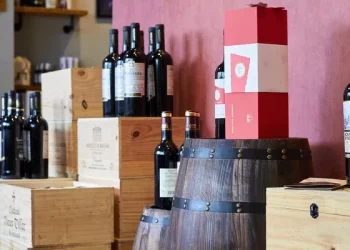In March 2004, Jancis Robinson MW questioned the quality of rose champagne, dismissing it as a passing fad.
Yet 10 years on, the rise of rose champagne has proved to be no flash in the pan, and it is now more popular than ever.
Rose champagne became popular in the mid-1980s, thanks to Mr. Allan Cheesman.
He recommends that marketers emphasize that this particular champagne is produced using the Saignee method.
Exsanguination is a method of making rose wine. During the fermentation of red wine, about 10% of the grape juice is banished, and this is the best wine used to make rose wine.
Another way to make rose champagne is by blending, which is more widely used.
This is done by adding 5 to 20 percent of the remaining red wine (typically pinot noir) to the remaining white wine, then bottling it and allowing it to undergo a secondary fermentation process in the bottle to produce the attractive rose champagne.
That is, the bloodletting method uses the natural color of grape juice, while the blending method uses a little red wine to create the desired color.
Marketers at the time compared the two methods, emphasizing that their rose champagne was made by exsanguine methods and was a huge success.
The success of ROSE champagne ignited both the ROSE WINE and CHAMPAGNE industries. When the merchants saw how popular rose champagne was, they decided to make it.
But producing champagne requires a long production cycle.
When a new batch of rose champagne, billed as the cheapest and youngest, began to hit the market in 1989, demand stagnated;
By 1991, when everyone was ready to release more rose champagne, there was a recession.
Therefore, resulting in a serious stock of rose champagne producers, a great loss.
Sales of rose champagne plummeted in the late 1990s before gradually recovering, from 5% of total champagne sales in 2004 to 10% today.
Today, almost every champagne producer produces at least one rose champagne.
No longer a fad, rose champagne has taken hold in the market.
At first, most manufacturers produced only according to their own standards.
In addition, few champagne houses make their own red wine, which they can only systematically buy through brokers in the region to make rose champagne.
As rose champagne production rose, so did the price of red wine, and as demand outweighed supply, speculative producers joined the fray, leaving some poor red wine on the market.
These wines lack pigment, have odd aromas, and have too much tannin.
As the demand for rose champagne continues to grow, and more and more of the poor quality red wines are coming in from speculators, producers are investing heavily in red wine making equipment.
Rose champagne is now scarce, excellent and expensive.
Rose wine made by mixing red and white wine is illegal throughout the European Union?
Or is there some inherent advantage to making rose champagne by letting blood out?
In fact, both the blood-letting method and the blending method can make dark or light color, rich or delicate taste, style or rough or elegant rose wine.
Either way, however, there is no inherent advantage.
In my experience, rose wines made with a certain type of mass maceration (exsanguination) have more problems with pigments, phenolic resins, and oxidation.
Why is rose champagne so expensive?
The producers of rose champagne also have to bear some additional costs, such as low-yielding vines and developing equipment for red wine making, but these are not the real reasons why rose champagne is expensive.
In 1991, AFTER experiencing a crisis in the ROSE CHAMPAGNE market, many producers paid special attention to the sale of rose champagne.
To avoid repeating the mistake, they include inventory costs.
Initially, it was a precautionary business decision.
After 17 years of steady growth, there is no inventory risk in the rose champagne market.
Although rose champagne is now firmly established in the market and no longer includes an “insurance premium”, its price is unlikely to go back down.
The latest market dynamics at any time to see, please pay attention to.












































